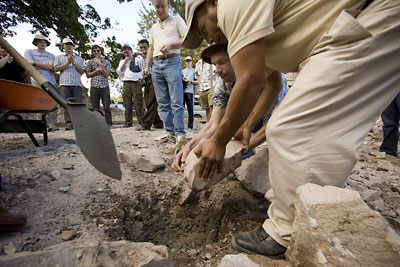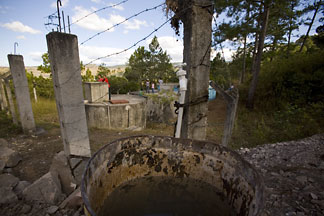CU students help celebrate a new chapter in Honduran town of Tamara -- the promise of clean, treated water
By Anne Ju


TÁMARA, Honduras -- It was a serenely simple groundbreaking event: a wheelbarrow full of cement, a small circle of stones, and a beaming crowd of Hondurans and visitors, among them a group of Cornell engineering students.
Amid the chatter in Spanish and English and the crunch of fresh cement, the students helped celebrate the start of a new chapter for the people of Támara, a town in central Honduras. As part of Cornell's AguaClara Project, the students spent last semester designing a water plant that will soon bring clean, treated water to Támara.
The ceremony on Jan. 13 was led by Támara's local water board and representatives of a Honduran organization, Agua Para el Pueblo ("Water for the People"), with whom Cornell worked to bring the plant to Támara. Also present were members of two Westchester County Rotary Clubs, Northeast Westchester Rotary and Somers Rotary, that have committed to raising more than $70,000 toward the water plant's construction.
Támara's story of clean water has a long prologue, which involves a blossoming partnership between the Cornell engineering students, their instructor, Monroe Weber-Shirk, and Agua Para el Pueblo.
Two courses Weber-Shirk teaches, an engineering course in Sustainable Small-Scale Water Supply, and a project course, AguaClara, are his students' connection with the Honduran water plants. In the water supply course they learn the technical aspects of water plant design for towns. In AguaClara, they work specifically on the Honduras plants. In recent years AguaClara students have partnered almost exclusively with Agua Para el Pueblo as the local organization that selects the plant sites that the students help design.
For the past five years, Weber-Shirk has taken groups of his students to Honduras during winter break so they can visit the communities they're working with and seek other potential water plant sites.
While in Honduras Jan. 4-20, the students visited municipal water plants, treatment sites and water sources in several Honduran towns. They also volunteered some construction and engineering design work for another water plant project in the town of Marcala. Several team members helped design the Marcala plant during the fall semester.
Weber-Shirk stresses that he brings students to Honduras so they can be immersed in the culture, people and conditions they're working with.
"Sure, we talk about the technology in class, and there are students on the team who are designing these plants, but there is nothing like actually seeing the physical structure, seeing how everything works, watching the plant operators drain a tank, disassemble it, clean it out and put it back together," he said.
During the fall semester, a group of five students worked on the Támara plant design, among them Rebecca Thompson '08, Raúl Santiago, M.Eng. '08, and Kolby Hoover '07, M.Eng. '08. All came on the January trip. Other students in Weber-Shirk's classes worked on technical designs and models, such as an automated design system for future plants.
The students worked on the Támara design with an Agua Para el Pueblo engineer and with two Cornell engineering alumni, Carol Serna '06, M.Eng. '07, and John Erickson '07, who are spending a year in Honduras working on AguaClara plants.
A previous generation of AguaClara students designed a water plant for the nearby town of Ojojona, whose plant has been operational since June 2007. This year's students used the Ojojona design for their base but made several improvements, such as a new leveling tank, which controls the water level in all parts of the plant.
Media Contact
Get Cornell news delivered right to your inbox.
Subscribe